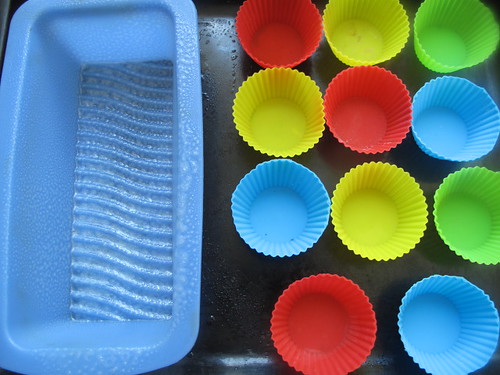It was my first couple of yoghurt cakes, or should I say my first ‘metal tin’ yoghurt cake versus my first silicone pan yoghurt cake which got me thinking about silicone. And when I say silicone, I refer not to the controversial stuff or the resin (used for children’s dinnerware) but to the new trend in bake ware!
Everywhere you look, you’ll find silicone on the store shelves, in a variety of shapes, colours, sizes and for various uses.
Silicone is often mistakenly referred to as “silicon.” Although silicones contain silicon atoms, they are not made up exclusively of silicon, and have completely different physical characteristics from elemental silicon.
I personally have a range of silicone products in my kitchen. I have spatulas, pastry brushes, egg poachers, baking tins, a cookie sheet and more. I like them, cause they’re very easy to clean and flexible. Silicone products are heat-resistant, they can withstand temperatures of up to 360 degrees centigrade though I always have a look at my specific utensil to find out its recommended temperatures.
Anyway, I wanted to make a cake which called for a Bundt pan. Since I didn’t have one, I borrowed one from my neighbour, made the cake and returned it. However, the cake turned out very nice (a tad too sweet though) and I thought if I was going to do a repeat, it was better if I got my own Bundt tin and so began the search which ended up in me buying a silicone Bundt pan – it was the only one I could find on the day I went a-looking.
Anyway, I was a bit skeptical about using it, as I’ve always had this things about plastic/rubberised cookware. I’m aware there’s a lot of controversy about what should and should not go into the microwave. And so as soon as I got it, I went a-googling, to find the ‘silicone’ test which I knew must exist. I came across an article which gave me tips on how to check the quality of silicone bake ware. So do this when you go out to buy:
Because some silicone products incorporate fillers, the product may not be 100%. You can check if they’re potentially compromised by pulling or pinching. If the product contains fillers, it will turn white. And of course, you know what to do then. Just in case you don’t know, I’ll say it – don’t buy.
Thankfully, mine was fine especially as I did the test at home, after the fact.
Some silicone bake ware is generally inexpensive in my opinion – I recently got a 12-pack of silicone cupcake moulds for under 2 Euros. Almost the same price as you’d get for cupcake paper liners. They are also quite colourful – I have seen them in almost every colour. In the same breath, I also have a set of egg poachers which I got for 10 euros! They’d better last for ever.
I’ve done numerous cake tests with metal and silicone and the key differences are:
Preparing the tins: Silicone moulds shouldn’t need greasing. They’re non-stick – a great, great plus for them.However, I prefer to grease them, spraying with some oil spray to allow easy release of my baked goods. I especially grease them when I’d like some ingredient to adhere to the sides like flaked almonds or desiccated coconut. Metal bake ware on the other hand must be greased in one way or the other. One tick for silicone
Putting in the oven: Funny I should mention it right, after all with metal tins, it’s not an issue that ever comes up. Well with silicone, it is a big and tricky issue- cold (into the oven) and hot (coming out of the oven). Because Silicone is lightweight and rubbery, it is flexible….. Extremely FLEXIBLE. So flexible that I’ve literally wrestled to keep some cake mixes from hitting the floor with a splatter, only a few minutes from baking heaven. (If you can conquer this, victory is yours. And I’ve learned the secret. Read on) But flexibility is not a problem you ever have with Metal so on this front, Metal wins hands down….
But I’ve found a solution to handling silicone pans, thanks to those who’ve been before me. So now if I’m using the silicone pans, I’ll make sure I start by getting out an oven tray or rack, and laying them on it before I fill the cakes. One tick for metal, sniff, sniff for Silicone.













































